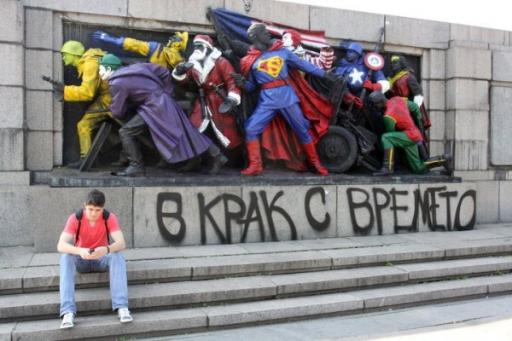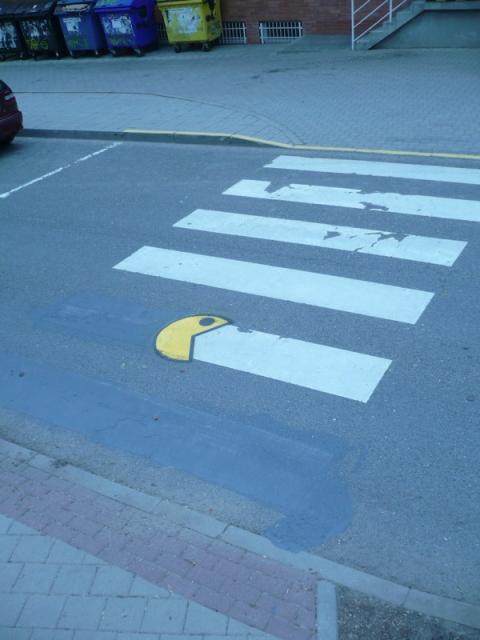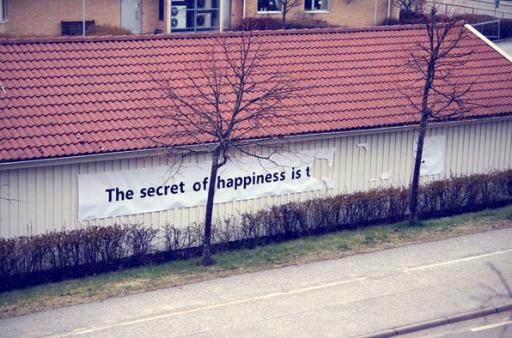The Null Device
2012/2/4
A French blog named Tout Bon has a gallery of the most interesting street art of 2011 (for varying definitions of "street art"):





And plenty more...
In 1995, the state legislature of New Mexico passed a law requiring psychologists and psychiatrists to be dressed as wizards when giving evidence in court:
When a psychologist or psychiatrist testifies during a defendant’s competency hearing, the psychologist or psychiatrist shall wear a cone-shaped hat that is not less than two feet tall. The surface of the hat shall be imprinted with stars and lightning bolts. Additionally, a psychologist or psychiatrist shall be required to don a white beard that is not less than 18 inches in length, and shall punctuate crucial elements of his testimony by stabbing the air with a wand. Whenever a psychologist or psychiatrist provides expert testimony regarding a defendant’s competency, the bailiff shall contemporaneously dim the courtroom lights and administer two strikes to a Chinese gong…The amendment passed unanimously, but was removed from the final law, to the detriment of the theatrical beard and Chinese gong industries.
There's a new article in WIRED interviewing members of the French underground explorers/guerilla repairers/real-life troglodistes UX; i.e., the people who set up a secret, fully outfitted cinema in the Parisian catacombs and subsequently covertly repared the clock in the Panthéon (and then made the mistake of notifying the officials responsible for the building, who deliberately broke it again out of spite); this article, largely drawn from an interview with one Lazar Kunstmann, has some details about the origins of the movement, its motivations, and some of its techniques:
Thirty years ago, in the dead of night, a group of six Parisian teenagers pulled off what would prove to be a fateful theft. They met up at a small cafè near the Eiffel Tower to review their plans—again—before heading out into the dark. Lifting a grate from the street, they descended a ladder to a tunnel, an unlit concrete passageway carrying a cable off into the void. They followed the cable to its source: the basement of the ministry of telecommunications. Horizontal bars blocked their way, but the skinny teens all managed to wedge themselves through and ascend to the building’s ground floor. There they found three key rings in the security office and a logbook indicating that the guards were on their rounds. But the guards were nowhere to be seen. The six interlopers combed the building for hours, encountering no one, until they found what they were looking for at the bottom of a desk drawer—maps of the ministry’s citywide network of tunnels. They took one copy of each map, then returned the keys to the security office.
In some places, UX has been able to create covert connections between networks, using (among other tricks) an invention they call the rolling basin. This is a passage in the bottom of a tunnel that appears to be a grate with water under it; in fact, both grate and water are part of a movable tray on rollers. Voilà trapdoor to another tunnel in a different network. The tray itself is made of concrete, so even if someone raps it with a stick, it sounds solid.
So what does the group do with all this access? Among other things, it has mounted numerous clandestine theater productions and film festivals. On a typical festival evening, they screen at least two films that they feel share a nonobvious yet provocative connection. They don’t explain the connection, leaving it up to the audience to try to discover it. One summer, the group mounted a film festival devoted to the theme of “urban deserts”—the forgotten and underutilized spaces in a city. They naturally decided the ideal venue for such a festival would be in just such an abandoned site.Kunstmann has some quite scathing words about the officials notionally responsible for the preservation of France's historical and cultural patrimony, a duty which UX claim they've derelicted:
Kunstmann has a gloomy view of contemporary civilization, and in his eyes this affair illustrates many of its worst faults—its fatalism, complacency, ignorance, parochialism, and negligence. French officials, he says, bother to protect and restore only the patrimony adored by millions—the Louvre, for example. Lesser-known sites are neglected, and if they happen to be out of public view—underground, say—they disintegrate totally, even when all that’s needed is a hundred-dollar leak repair. UX tends the black sheep: the odd, the unloved, the forgotten artifacts of French civilization.
It seems that the problem is exacerbated by a culture of officiousness endemic to France's public service, where the purpose of an office is often overshadowed by the ego of the holder of the office and his (or hers, though, to be honest, usually his) need to stake out turf and engage in territorial pissing matches. Hence the neglect of anything not immediately prestigious and the active hostility to those who show up said official neglect by doing something about it.
UX have learned their lesson from the Panthéon incident; since then, they claim to have repaired some 15 other sites, though have kept the details secret:
I ask him to elaborate on their choice of projects. “We can say very little,” he replies, “because to describe the sites even a bit can give away their location.” That said, one site is “belowground, in the south of Paris, not very far from here. It was discovered relatively recently but elicited very strong interest. It totally contradicts the history of the building above it. In examining what’s belowground, one notices that it doesn’t correspond to the information one can obtain about the history of the site. It’s history in reverse, in a way; the site was dedicated to an activity, structures were placed there, but in fact the site had been dedicated to this activity for quite a long time.”